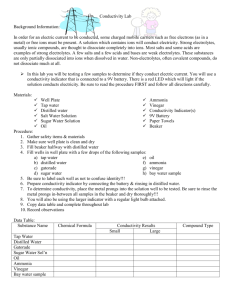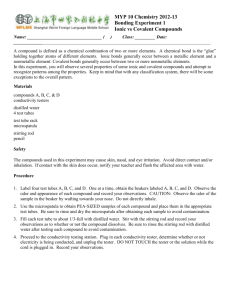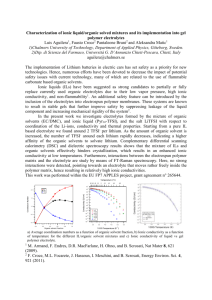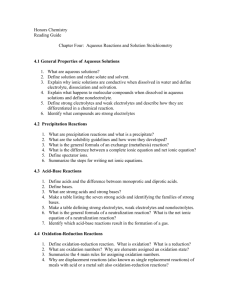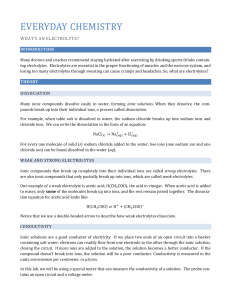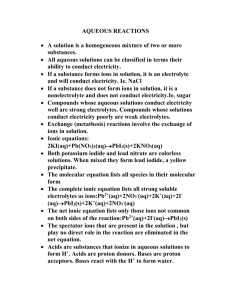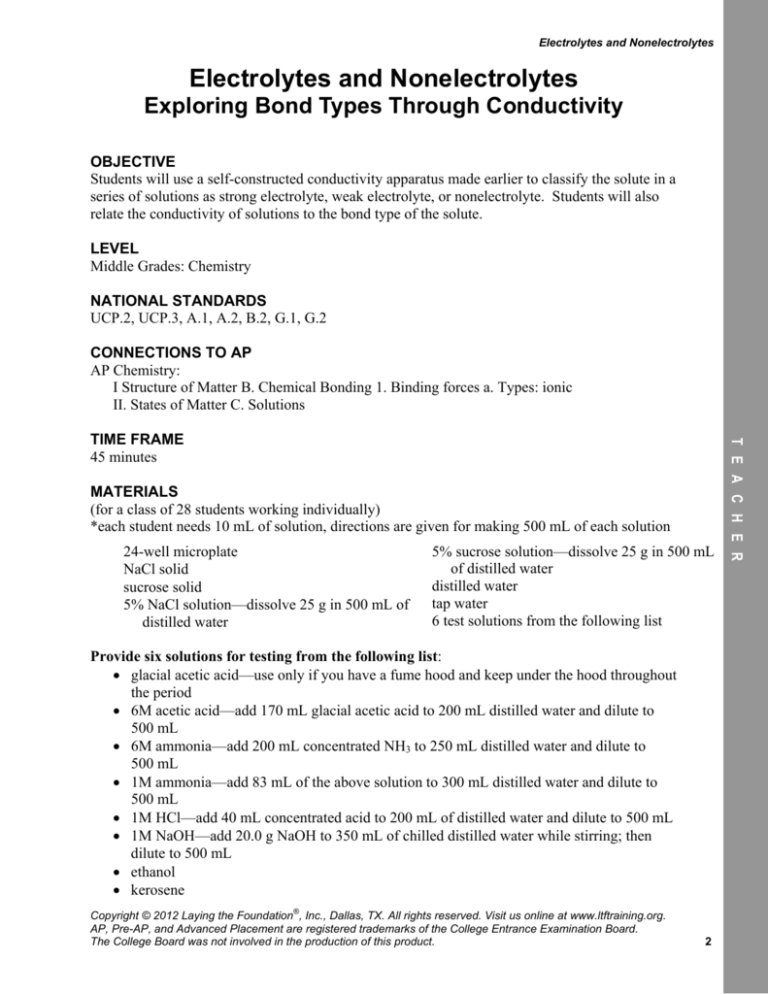
Electrolytes and Nonelectrolytes
Electrolytes and Nonelectrolytes
Exploring Bond Types Through Conductivity
OBJECTIVE
Students will use a self-constructed conductivity apparatus made earlier to classify the solute in a
series of solutions as strong electrolyte, weak electrolyte, or nonelectrolyte. Students will also
relate the conductivity of solutions to the bond type of the solute.
LEVEL
Middle Grades: Chemistry
NATIONAL STANDARDS
UCP.2, UCP.3, A.1, A.2, B.2, G.1, G.2
CONNECTIONS TO AP
AP Chemistry:
I Structure of Matter B. Chemical Bonding 1. Binding forces a. Types: ionic
II. States of Matter C. Solutions
MATERIALS
(for a class of 28 students working individually)
*each student needs 10 mL of solution, directions are given for making 500 mL of each solution
24-well microplate
NaCl solid
sucrose solid
5% NaCl solution—dissolve 25 g in 500 mL of
distilled water
5% sucrose solution—dissolve 25 g in 500 mL
of distilled water
distilled water
tap water
6 test solutions from the following list
Provide six solutions for testing from the following list:
glacial acetic acid—use only if you have a fume hood and keep under the hood throughout
the period
6M acetic acid—add 170 mL glacial acetic acid to 200 mL distilled water and dilute to
500 mL
6M ammonia—add 200 mL concentrated NH3 to 250 mL distilled water and dilute to
500 mL
1M ammonia—add 83 mL of the above solution to 300 mL distilled water and dilute to
500 mL
1M HCl—add 40 mL concentrated acid to 200 mL of distilled water and dilute to 500 mL
1M NaOH—add 20.0 g NaOH to 350 mL of chilled distilled water while stirring; then
dilute to 500 mL
ethanol
kerosene
®
Copyright © 2012 Laying the Foundation , Inc., Dallas, TX. All rights reserved. Visit us online at www.ltftraining.org.
AP, Pre-AP, and Advanced Placement are registered trademarks of the College Entrance Examination Board.
The College Board was not involved in the production of this product.
2
T E A C H E R
TIME FRAME
45 minutes
Electrolytes and Nonelectrolytes
glycerin
any other nitrate or chloride salts [except silver, mercury or lead] you have on hand—
make a 5% solution by taking 25 g of the salt and dissolving it in 500 mL of distilled
water
Safety Alert
1. Goggles and aprons must be worn at all times.
2. Use extreme caution when handling chemicals: Do not inhale any vapors during
this laboratory and make sure there is adequate ventilation.
3. Clearly label all solutions.
4. Label the ethanol and kerosene CAUTION: Flammable.
5. Make sure there are no open flames or hot plates allowed in the lab room during
this exercise.
T E A C H E R
TEACHER NOTES
This laboratory exercise should be performed after students have constructed their conductivity
apparatus according to the procedure presented in the Laying the Foundations® Light Up My
Life. Alternatively, you may purchase a conductivity apparatus from a science supply company.
The procedure is written to use 24-well microplates so either purchase devices that allow the
electrodes to fit within that small well or modify the procedure to use larger cups or beakers to
contain the solutions. It is also possible to conduct this exercise as a teacher demonstration if
necessary.
Dispensing solutions in small dropper bottles minimizes contamination. If you must dispense
from open containers clearly label a disposable pipet for each solution and caution students
against cross contamination.
®
Copyright © 2012 Laying the Foundation , Inc., Dallas, TX. All rights reserved. Visit us online at www.ltftraining.org.
3
POSSIBLE ANSWERS TO THE CONCLUSION QUESTIONS AND SAMPLE DATA
Data Table
Substance tested:
Classification:
Predicted Bonding:
Ions present in
electrolytes
NaCl solid
NE
ionic
Na+ and Cl- BUT
locked in the solid
lattice
Sucrose solid
NE
covalent
NaCl solution
SE
ionic
Sucrose solution
NE
covalent
distilled water
NE
tap water
WE
kerosene
NE
1M HCl
SE
ionic
H+ and Cl-
1M NaOH
SE
ionic
Na+ and OH-
glacial acetic acid
NE
covalent
6M acetic acid
WE
ionic [water partially ionizes the
acid]
H+ and C2H3O2-
6M NH3
WE
ionic [water partially ionizes the
base]
OH- and NH4+
1M NH3
WE
ionic [water partially ionizes the
base]
OH- and NH4+
ethanol
NE
covalent
glycerine
NE
covalent
any nitrate salt
SE
ionic
cation and NO3-
any chloride salt
[except silver,
mercury or lead]
SE
ionic
cation and Cl-
Mg2+, Ca2+, Cl-, F-, etc.
T E A C H E R
covalent
covalent with ions [if the tap water
in your area doesn’t make the LED
glow, you may have to « cheat »
and add some salt to make this
point !]
covalent
Na+ and Cl-
1. What are the characteristics of a strong electrolyte solution?
strong electrolytes must first be soluble in water
strong electrolytes must be ionically bonded in order to release ions into solution
the number of ions is also important; strong electrolytes dissociate completely in solution
2. For each strong or weak electrolyte write the symbols of the ions that are present in a
solution of the substance.
See the table above for these answers. NOTE that students may classify ammonia and acetic
acid as ionically bonded. Acetic acid is a weak acid and ammonia is a weak base which
means that they exist as molecules most of the time, but do dissociate to some degree in
solution. A 6.0 molar solution is used so that enough dissociation takes place to give a
reading. Review the electronegativities of the bonds involved with students to clear up
any misconceptions.
3. Compare the conductivity of solid sodium chloride to a solution of sodium chloride.
Explain any differences observed.
Solid sodium chloride did NOT conduct and electric current even though ions exist. The ions
are not free to move about; they are fixed in a crystal lattice.
When sodium chloride is dissolved in water, its ions are free to move and thus an electric
current is conducted.
T E A C H E R
4. Compare and contrast the bonding of electrolytes and nonelectrolytes. Be sure and
include the characteristics of each in your discussion.
Electrolytes are often ionically bonded and water soluble. Upon dissolving, they release
charged ions that conduct an electric current.
Nonelectrolytes are covalently bonded. When they dissolve in water they remain in solution
as neutral molecules and thus do not conduct an electric current.
Electrolytes and Nonelectrolytes
Electrolytes and Nonelectrolytes
Exploring Bond Types Through Conductivity
Do you know why electrical devices caution against using them near water? If an electrical
device falls into water in which you are standing, you could receive a severe or even fatal shock.
Rain and tap water contain small amounts of dissolved ions that allow the solution to conduct
electricity. A perfectly pure sample of water, containing only H2O molecules, conducts only a
very minute electric current and poses no harm. Only about 2 per billion water molecules
spontaneously separate into H+ ions and OH- ions and therefore do not produce enough charged
particles to carry a current that is measurable in most school science laboratories. When ionic
substances dissolve in water, ions separate from each other. The charged particles released
conduct an electric current through the water. If the substance ionizes almost completely in
water, it is a good conductor of electricity and is classified as a strong electrolyte. If a substance
ionizes only partially, it is a poor conductor of electricity and is classified as a weak electrolyte.
Most of the solutes of both types of electrolytes are ionically bonded. Substances that dissolve in
water without conducting an electric current are classified as nonelectrolytes. Nonelectrolytes
usually contain covalent bonds and do not dissociate into ions when they dissolve in water. We
call these solutes molecular solutes.
PURPOSE
To use either the conductivity apparatus you have constructed or one provided by your teacher to
classify the solute in a series of solutions as strong electrolytes, weak electrolytes, or
nonelectrolytes. You will also relate the conductivity of these solutions to the bond type of the
solute.
MATERIALS
conductivity apparatus
24-well microplate
NaCl solid
sucrose solid
solutions provided by your teacher
Safety Alert
1. Goggles and aprons must be worn at all times.
2. Use extreme caution when handling chemicals: Do not inhale any vapors during
this laboratory and make sure there is adequate ventilation.
3. Clearly label all solutions.
4. Label the ethanol and kerosene CAUTION: Flammable.
5. Make sure there are no open flames or hot plates allowed in the lab room during
this exercise.
®
Copyright © 2012 Laying the Foundation , Inc., Dallas, TX. All rights reserved. Visit us online at www.ltftraining.org.
4
Electrolytes and Nonelectrolytes
PROCEDURE
1. Formulate a hypothesis in using the if-then format which relates a solute’s conductivity to the
type of bonding it exhibits.
2. Make a diagram of your 24-well microplate on your student answer page.
3. List the solutions to be tested in the data table on your student answer page.
4. Fill separate wells half-full with each solid to be tested. Clearly label the wells on your
diagram.
5. Place 10 drops of each test solution into a separate well. Clearly label the wells on your
diagram.
6. Insert both of the electrodes of the conductivity tester into the first well. The electrodes must
NOT touch each other.
7. Note the relative conductivity of the solids and solutions by monitoring the brightness of the
LED. Record your observations in the data table on your student answer page using the
following code:
SE = strong electrolyte [LED glows bright]
WE = weak electrolyte [LED glows dim]
NE = nonelectrolytes [LED produces no light]
8. Predict the bond type for each substance tested and record you results in the data table on
your student answer pages.
®
Copyright © 2012 Laying the Foundation , Inc., Dallas, TX. All rights reserved. Visit us online at www.ltftraining.org.
5
Electrolytes and Nonelectrolytes
Electrolytes and Nonelectrolytes
Exploring Bond Types Through Conductivity
HYPOTHESIS
DATA AND OBSERVATIONS
Make a diagram of your 24-well microplate in the space provided below:
®
Copyright © 2012 Laying the Foundation , Inc., Dallas, TX. All rights reserved. Visit us online at www.ltftraining.org.
6
Electrolytes and Nonelectrolytes
ANALYSIS
Data Table
Substance being tested
Electrolyte
Classification
Predicted Bonding
NaCl solid
Sucrose solid
NaCl solution
Sucrose solution
distilled water
tap water
CONCLUSION QUESTIONS
1. What are the characteristics of a strong electrolyte solution?
2. For each strong or weak electrolyte write the symbols of the ions that are present in a
solution of the substance.
3. Compare the conductivity of solid sodium chloride to a solution of sodium chloride. Explain
any differences observed.
®
Copyright © 2012 Laying the Foundation , Inc., Dallas, TX. All rights reserved. Visit us online at www.ltftraining.org.
7
Electrolytes and Nonelectrolytes
4. Compare and contrast the bonding of electrolytes and nonelectrolytes. Be sure and include
the characteristics of each in your discussion.
®
Copyright © 2012 Laying the Foundation , Inc., Dallas, TX. All rights reserved. Visit us online at www.ltftraining.org.
8

